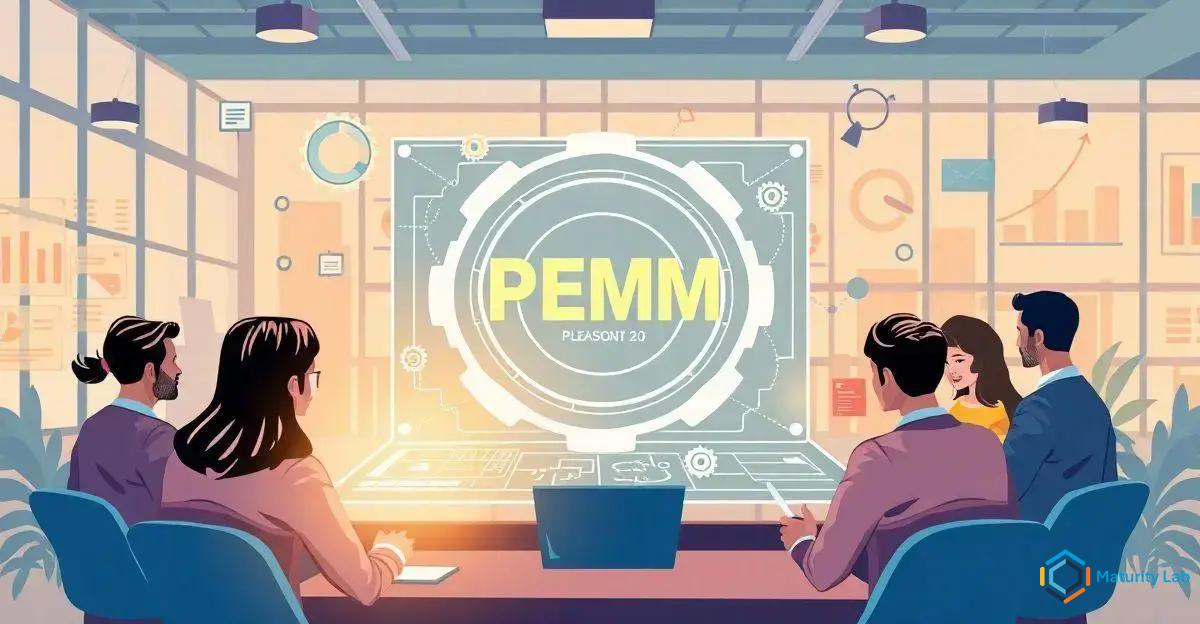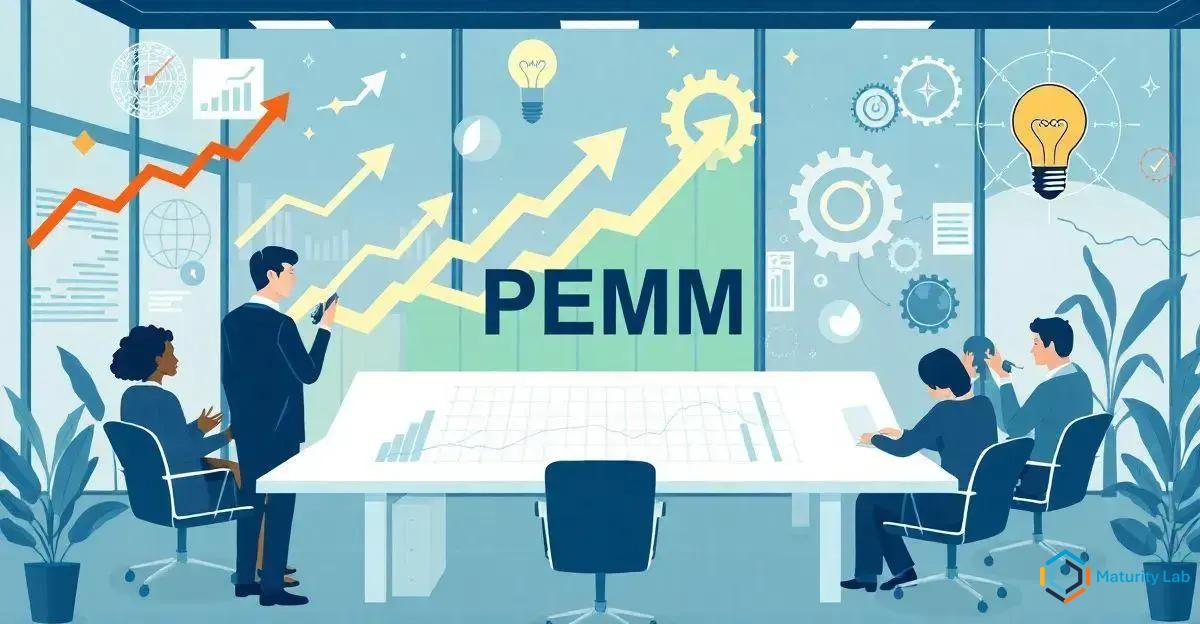The Process and Enterprise Maturity Model (PEMM) is a framework aimed at improving organizational maturity by assessing both process-specific and enterprise-wide factors, including Process Enablers and Enterprise Capabilities. It emphasizes the importance of leadership in fostering a culture of continuous improvement and aligning goals with process enhancements. PEMM stands out from other models like CMMI and BPMM by providing a holistic approach for sustainable growth. Implementing PEMM involves assessing current states, prioritizing improvements, and ensuring effective communication for long-term benefits and enhanced performance.
In today’s competitive business environment, understanding and enhancing organizational maturity is crucial for sustained success. The Process and Enterprise Maturity Model (PEMM) offers a comprehensive framework to evaluate and improve your organization’s processes. By integrating effective leadership strategies, businesses can leverage PEMM to achieve higher levels of performance and efficiency. This article delves into the intricacies of PEMM, explores the pivotal role of leadership in organizational maturity, and compares PEMM with other renowned maturity models.
Understanding the PEMM Framework

The Process and Enterprise Maturity Model (PEMM) is a robust framework designed to assess and enhance the maturity of an organization’s processes and overall enterprise capabilities. Developed by Michael Hammer, PEMM provides a structured approach to evaluate the effectiveness of business processes and the readiness of an organization to execute these processes efficiently.
PEMM is built upon two main components: Process Enablers and Enterprise Capabilities. Process Enablers focus on the specific attributes that make a process effective, including design, performers, owner, infrastructure, and metrics. Each of these enablers is critical in ensuring that processes are not only well-designed but also executed with precision and consistency. For instance, the design enabler ensures that the process is structured to meet its objectives, while the performers enabler focuses on the skills and competencies of the individuals executing the process.
On the other hand, Enterprise Capabilities pertain to the broader organizational attributes that support effective process execution. These capabilities include leadership, culture, expertise, governance, and people. Leadership, for example, plays a pivotal role in driving process improvements and fostering a culture of continuous enhancement. Governance ensures that there are clear policies and accountability mechanisms in place to support process adherence and performance.
The PEMM framework is unique in its dual focus on both process-specific and enterprise-wide factors, providing a holistic view of organizational maturity. By assessing both Process Enablers and Enterprise Capabilities, organizations can identify specific areas for improvement and develop targeted strategies to enhance their overall maturity. This comprehensive approach ensures that improvements in process efficiency are supported by a conducive organizational environment, leading to sustainable business growth.
To illustrate, consider a manufacturing company aiming to improve its production processes. By applying the PEMM framework, the company can evaluate the design of its production process, the skills of its workers, and the supporting infrastructure. Simultaneously, it can assess the leadership’s commitment to process improvement, the organizational culture’s alignment with continuous improvement principles, and the governance structures in place. This dual assessment enables the company to develop a well-rounded action plan that addresses both process-specific and enterprise-wide factors, ultimately leading to enhanced productivity and efficiency.
The Role of Leadership in Organizational Maturity

The Role of Leadership in Organizational Maturity
Leadership is a cornerstone of organizational maturity, influencing every facet of a company’s ability to grow and adapt. Effective leadership not only drives the strategic vision but also fosters an environment where continuous improvement and innovation can thrive. In the context of the Process and Enterprise Maturity Model (PEMM), leadership is a critical enterprise capability that underpins the successful implementation and sustainability of mature processes.
Leaders play a pivotal role in setting the tone for organizational culture, which is essential for achieving high levels of maturity. A culture that values transparency, accountability, and continuous learning encourages employees to engage actively in process improvements. Leaders who exemplify these values and behaviors inspire their teams to follow suit, creating a ripple effect that permeates the entire organization.
Moreover, leadership is instrumental in aligning organizational goals with process improvements. By clearly communicating the strategic objectives and the importance of mature processes in achieving these goals, leaders can ensure that every team member understands their role in the broader organizational context. This alignment is crucial for fostering a sense of purpose and direction, which are key drivers of employee engagement and motivation.
In addition to cultural and strategic alignment, leadership is responsible for resource allocation and capability development. Mature organizations require investments in training, technology, and infrastructure to support advanced processes. Leaders must prioritize these investments and ensure that resources are allocated efficiently to areas that will yield the highest returns. This includes not only financial resources but also time and attention, as leaders must be actively involved in mentoring and coaching their teams.
Effective governance is another area where leadership plays a critical role. Governance structures provide the framework for decision-making, accountability, and performance measurement. Leaders must establish and enforce governance policies that support process adherence and continuous improvement. This includes setting clear expectations, monitoring performance, and taking corrective actions when necessary.
Consider a healthcare organization aiming to enhance its patient care processes. Leadership in such a setting would involve not only setting a vision for high-quality patient care but also ensuring that the necessary resources, training, and governance structures are in place. Leaders would need to foster a culture of empathy and excellence, align process improvements with patient care objectives, and monitor performance rigorously. By doing so, they can drive the organization towards higher maturity levels, resulting in better patient outcomes and operational efficiency.
In summary, leadership is integral to achieving and sustaining organizational maturity. Through cultural influence, strategic alignment, resource allocation, and effective governance, leaders can create an environment where mature processes can flourish, driving long-term success and resilience.
Comparing PEMM with Other Maturity Models

Implementing the Process and Enterprise Maturity Model (PEMM) can significantly contribute to business growth by systematically enhancing both process efficiency and enterprise capabilities. The implementation process involves several key steps that organizations must follow to achieve the desired outcomes.
The first step in implementing PEMM is to conduct a comprehensive assessment of the current state of the organization’s processes and enterprise capabilities. This involves evaluating the five Process Enablers—design, performers, owner, infrastructure, and metrics—and the five Enterprise Capabilities—leadership, culture, expertise, governance, and people. This assessment provides a clear understanding of the organization’s strengths and areas for improvement, serving as the foundation for developing a targeted action plan.
Once the assessment is complete, the next step is to prioritize the areas that require immediate attention. Organizations should focus on the Process Enablers and Enterprise Capabilities that have the most significant impact on their strategic objectives. For example, if a company aims to improve its customer service processes, it might prioritize enhancing the design and metrics of these processes while also focusing on leadership and culture to support the changes.
Developing a detailed action plan is crucial for the successful implementation of PEMM. This plan should outline specific initiatives, timelines, and responsibilities for addressing the identified areas of improvement. It is essential to involve key stakeholders in this planning process to ensure buy-in and commitment across the organization. The action plan should also include mechanisms for monitoring progress and measuring the impact of the initiatives.
Training and development play a vital role in the implementation of PEMM. Organizations must invest in building the skills and competencies of their employees to execute the improved processes effectively. This includes providing training on new process designs, performance metrics, and the use of supporting infrastructure. Additionally, leadership development programs can help cultivate the necessary enterprise capabilities, such as effective governance and a culture of continuous improvement.
Effective communication is another critical factor in the successful implementation of PEMM. Leaders must clearly communicate the purpose, benefits, and expected outcomes of the PEMM initiatives to all employees. This helps to build understanding and support for the changes, reducing resistance and fostering a collaborative environment. Regular updates on the progress of the initiatives can also help maintain momentum and engagement.
Finally, organizations must establish mechanisms for continuous improvement to sustain the benefits of PEMM. This involves regularly reviewing and updating the Process Enablers and Enterprise Capabilities to ensure they remain aligned with the organization’s strategic objectives. Continuous improvement processes, such as regular audits and feedback loops, can help identify new areas for enhancement and ensure that the organization continues to evolve and grow.
For instance, a retail company implementing PEMM to improve its supply chain processes might start by assessing the design and infrastructure of these processes. Based on the assessment, the company could develop an action plan that includes initiatives such as redesigning the supply chain process, investing in new technology, and providing training for employees. By also focusing on leadership and governance, the company can ensure that these improvements are supported and sustained over the long term, leading to increased efficiency and business growth.
In conclusion, implementing PEMM requires a structured and systematic approach that involves assessing the current state, prioritizing areas for improvement, developing a detailed action plan, investing in training and development, communicating effectively, and establishing mechanisms for continuous improvement. By following these steps, organizations can leverage PEMM to enhance their processes and enterprise capabilities, driving sustainable business growth.
Implementing PEMM for Business Growth

Implementing the Process and Enterprise Maturity Model (PEMM) can significantly contribute to business growth by systematically enhancing both process efficiency and enterprise capabilities. The implementation process involves several key steps that organizations must follow to achieve the desired outcomes.
The first step in implementing PEMM is to conduct a comprehensive assessment of the current state of the organization’s processes and enterprise capabilities. This involves evaluating the five Process Enablers—design, performers, owner, infrastructure, and metrics—and the five Enterprise Capabilities—leadership, culture, expertise, governance, and people. This assessment provides a clear understanding of the organization’s strengths and areas for improvement, serving as the foundation for developing a targeted action plan.
Once the assessment is complete, the next step is to prioritize the areas that require immediate attention. Organizations should focus on the Process Enablers and Enterprise Capabilities that have the most significant impact on their strategic objectives. For example, if a company aims to improve its customer service processes, it might prioritize enhancing the design and metrics of these processes while also focusing on leadership and culture to support the changes.
Developing a detailed action plan is crucial for the successful implementation of PEMM. This plan should outline specific initiatives, timelines, and responsibilities for addressing the identified areas of improvement. It is essential to involve key stakeholders in this planning process to ensure buy-in and commitment across the organization. The action plan should also include mechanisms for monitoring progress and measuring the impact of the initiatives.
Training and development play a vital role in the implementation of PEMM. Organizations must invest in building the skills and competencies of their employees to execute the improved processes effectively. This includes providing training on new process designs, performance metrics, and the use of supporting infrastructure. Additionally, leadership development programs can help cultivate the necessary enterprise capabilities, such as effective governance and a culture of continuous improvement.
Effective communication is another critical factor in the successful implementation of PEMM. Leaders must clearly communicate the purpose, benefits, and expected outcomes of the PEMM initiatives to all employees. This helps to build understanding and support for the changes, reducing resistance and fostering a collaborative environment. Regular updates on the progress of the initiatives can also help maintain momentum and engagement.
Finally, organizations must establish mechanisms for continuous improvement to sustain the benefits of PEMM. This involves regularly reviewing and updating the Process Enablers and Enterprise Capabilities to ensure they remain aligned with the organization’s strategic objectives. Continuous improvement processes, such as regular audits and feedback loops, can help identify new areas for enhancement and ensure that the organization continues to evolve and grow.
For instance, a retail company implementing PEMM to improve its supply chain processes might start by assessing the design and infrastructure of these processes. Based on the assessment, the company could develop an action plan that includes initiatives such as redesigning the supply chain process, investing in new technology, and providing training for employees. By also focusing on leadership and governance, the company can ensure that these improvements are supported and sustained over the long term, leading to increased efficiency and business growth.
In conclusion, implementing PEMM requires a structured and systematic approach that involves assessing the current state, prioritizing areas for improvement, developing a detailed action plan, investing in training and development, communicating effectively, and establishing mechanisms for continuous improvement. By following these steps, organizations can leverage PEMM to enhance their processes and enterprise capabilities, driving sustainable business growth.
In conclusion, the Process and Enterprise Maturity Model (PEMM) provides a comprehensive framework for assessing and enhancing both process-specific and enterprise-wide capabilities.
By understanding the intricacies of the PEMM framework, organizations can identify critical areas for improvement and develop targeted strategies to elevate their maturity levels.
Leadership plays a pivotal role in this journey, driving cultural alignment, strategic focus, resource allocation, and effective governance to support mature processes.
Comparison with Other Models
Comparing PEMM with other maturity models such as CMMI, OPM3, and BPMM highlights its unique dual focus on Process Enablers and Enterprise Capabilities, offering a more holistic approach to achieving organizational maturity.
This comprehensive perspective ensures that process improvements are not only implemented effectively but also sustained over the long term, fostering continuous growth and resilience.
Implementing PEMM involves a structured approach that includes conducting a thorough assessment, prioritizing key areas for improvement, developing a detailed action plan, investing in training and development, and maintaining effective communication.
By establishing mechanisms for continuous improvement, organizations can ensure that their processes and enterprise capabilities remain aligned with strategic objectives, driving sustainable business growth.
Ultimately, leveraging PEMM enables organizations to create a conducive environment for mature processes to flourish, leading to enhanced performance, efficiency, and long-term success.
By integrating PEMM into their strategic initiatives, businesses can navigate the complexities of today’s competitive landscape and achieve higher levels of organizational maturity.
Frequently Asked Questions about PEMM, Organizational Maturity, and Leadership
What is the Process and Enterprise Maturity Model (PEMM)?
PEMM is a comprehensive framework developed by Michael Hammer to assess and enhance the maturity of an organization’s processes and enterprise capabilities. It focuses on both Process Enablers and Enterprise Capabilities to provide a holistic view of organizational maturity.
How does leadership influence organizational maturity?
Leadership plays a critical role in driving organizational maturity by setting the strategic vision, fostering a culture of continuous improvement, aligning organizational goals with process improvements, allocating resources efficiently, and establishing effective governance structures.
How does PEMM compare to other maturity models like CMMI, OPM3, and BPMM?
While CMMI, OPM3, and BPMM focus primarily on process-specific factors, PEMM offers a more holistic approach by integrating both Process Enablers and Enterprise Capabilities. This dual focus ensures that process improvements are supported by a conducive organizational environment, leading to sustainable business growth.
What are the key steps in implementing PEMM?
Implementing PEMM involves conducting a comprehensive assessment of current processes and enterprise capabilities, prioritizing areas for improvement, developing a detailed action plan, investing in training and development, communicating effectively, and establishing mechanisms for continuous improvement.
Why is effective communication important in implementing PEMM?
Effective communication helps build understanding and support for PEMM initiatives, reducing resistance and fostering a collaborative environment. It ensures that all employees are aware of the purpose, benefits, and expected outcomes of the changes, maintaining momentum and engagement.
How can organizations sustain the benefits of PEMM?
Organizations can sustain the benefits of PEMM by regularly reviewing and updating Process Enablers and Enterprise Capabilities to ensure alignment with strategic objectives. Continuous improvement processes, such as regular audits and feedback loops, help identify new areas for enhancement and ensure ongoing growth.

